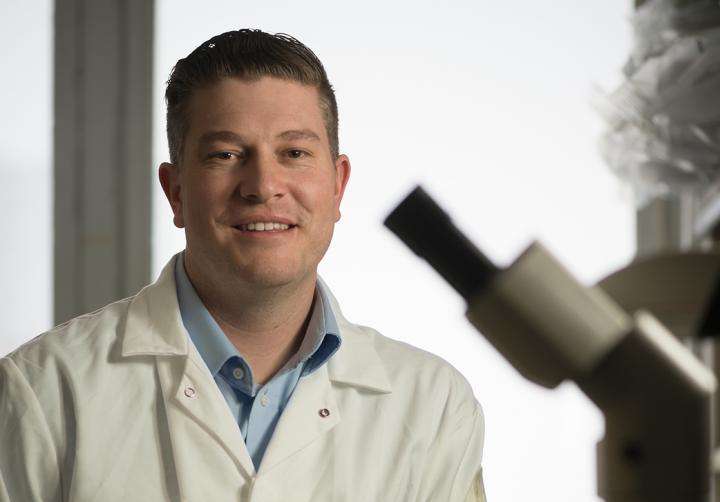Tony Parenti led a team of MSU scientists in discovering a new kind of stem cell, one that could lead to advances in regenerative medicine as well as offer new ways to study birth defects and other reproductive problems. Credit: G.L. Kohuth
Scientists at Michigan State University have discovered a new kind of stem cell, one that could lead to advances in regenerative medicine as well as offer new ways to study birth defects and other reproductive problems.
In the current issue of the journal Stem Cell Reports, Tony Parenti, lead author and MSU cell and molecular biology graduate student, unearthed the new cells - induced XEN cells, or iXEN - in a cellular trash pile, of sorts.
"Other scientists may have seen these cells before, but they were considered to be defective, or cancer-like," said Parenti, who works in the lab of Amy Ralston, MSU biochemist, cell and molecular biologist and co-author of the study. "Rather than ignore these cells that have been mislabeled as waste byproducts, we found gold in the garbage."
A great deal of stem cell research focuses on new ways to make and use pluripotent stem cells. Pluripotent stem cells can be created by reactivating embryonic genes to "reprogram" mature adult cells. Reprogramming mature cells into induced pluripotent stem cells, or iPS cells, allows them to become malleable building blocks that can morph into any cell in the body.
For example, if a patient has a defective liver, healthy cells could be taken from the patient, reprogrammed into iPS cells, which could then be used to help regenerate the person's failing organ. Taking cells from the same patient may greatly reduce the chance of the body rejecting the new treatment, Parenti said.
Prior to the discovery of reprogramming, scientists developed pluripotent stem cells from embryos. However, the embryo produces not only pluripotent stem cells, but also XEN cells, a stem cell type with unique properties. While pluripotent stem cells produce cells in the body, XEN cells produce extraembryonic tissues that play an essential but indirect role in fetal development.
Parenti and his team speculated that if the embryo produces both pluripotent and XEN cells, this might also occur during reprogramming.
The eureka moment came when Parenti discovered colonies of iXEN cells popping up like weeds in his iPS cell cultures. Using mice models, the team spent six months proving that these genetic weeds are not cancer-like, as previously suspected, but in fact, a new kind of stem cell with desirable properties.
Even more surprising, the team found that by inhibiting expression of XEN genes during reprogramming, they could decrease production of iXEN cells and increase production of iPS cells.
"Nature makes stem cells perfectly, but we are still trying to improve our stem cell production," Parenti said. "We took what we learned by studying the embryo and applied it to reprogramming, and this opened up a new way to optimize reprogramming."
The team wouldn't have made this breakthrough without the high level of collaboration and access to cutting-edge facilities at Michigan State, he added.
The next steps of this research will involve seeing if this process occurs in human cells. XEN cells have yet to be discovered in humans, but the possibility of their existence is a key focus of the field.
"It's a missing tool that we don't have yet," Ralston said. "It's true that XEN cells have characteristics that pluripotent stem cells do not have. Because of those traits, iXEN cells can shed light on reproductive diseases. If we can continue to unlock the secrets of iXEN cells, we may be able to improve induced pluripotent stem cell quality and lay the groundwork for future research on tissues that protect and nourish the human embryo."
More information: Ge Guo et al. Naive Pluripotent Stem Cells Derived Directly from Isolated Cells of the Human Inner Cell Mass, Stem Cell Reports (2016). DOI: 10.1016/j.stemcr.2016.02.005
Journal information: Stem Cell Reports
Provided by Michigan State University






















